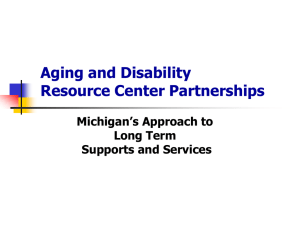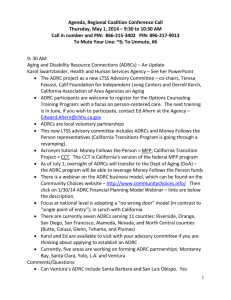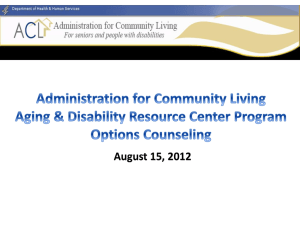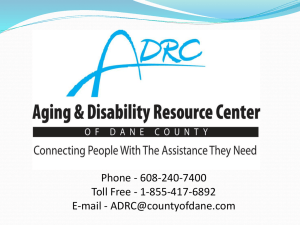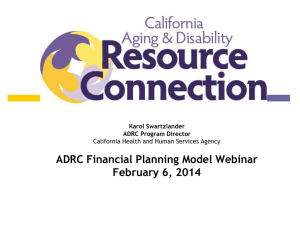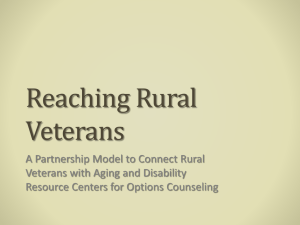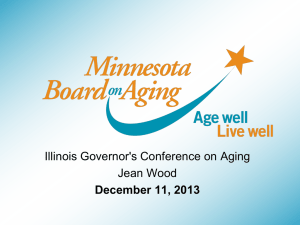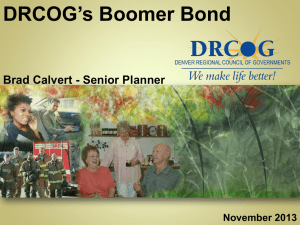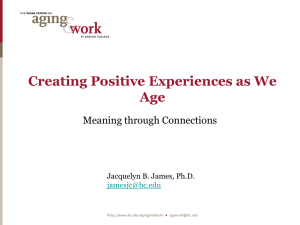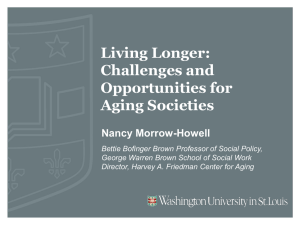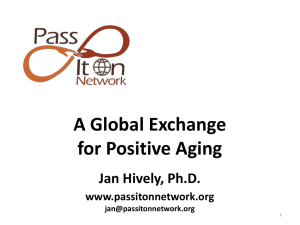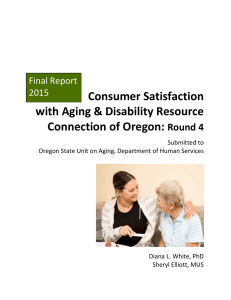Bridging the Networks in Florida: Part V
advertisement
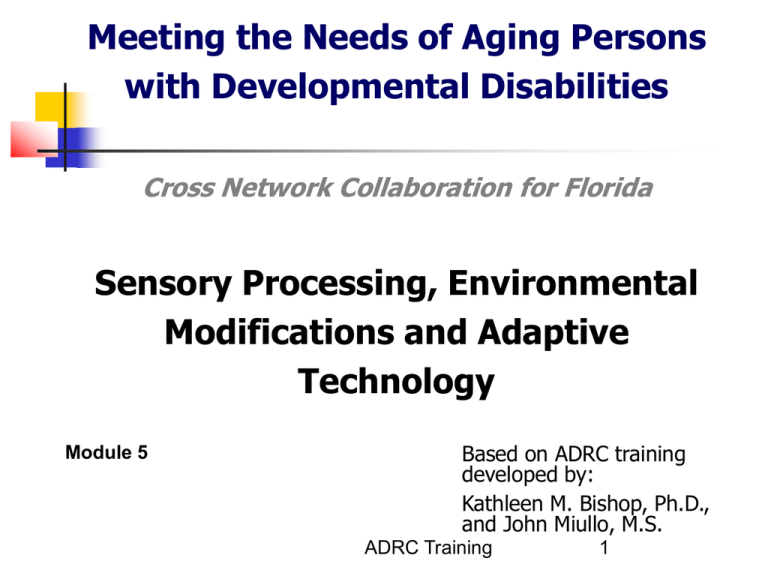
Meeting the Needs of Aging Persons with Developmental Disabilities Cross Network Collaboration for Florida Sensory Processing, Environmental Modifications and Adaptive Technology Module 5 Based on ADRC training developed by: Kathleen M. Bishop, Ph.D., and John Miullo, M.S. ADRC Training 1 Purpose of Module 5 Detail how older adults and individuals with developmental disabilities: Interact with the physical environment and adaptive technology Have the same environmental/sensory issues ADRC Training 2 Purpose of Module 5 Outline techniques for individuals and their families to: Reduce the impact of sensory changes Maintain independence Address common challenges they share with each other Experience quality of life through use of adaptive environment and technology ADRC Training 3 Meeting the Needs of Aging Persons with Developmental Disabilities Cross Network Collaboration for Florida Sensory Processing ADRC Training 4 Sensory Changes and Aging Increase in impairments with aging Increase in sensory changes Potential for reduction in quality of life and independence Common experience as people age regardless of pre-existing disabilities ADRC Training 5 Importance of the Environment Immediate environment increasingly important with aging Reduction of barriers to community participation and social interaction essential Balance of ease of use and challenge Changing with age and increased impairments ADRC Training 6 Sensory Processing and Aging All information for functioning taken in from sensory information in the environment Brain must Be aware of sensory stimuli Receive the information accurately Bring the information together through processing Interpret information to determine response ADRC Training 7 Sensory Processing and Aging Ongoing process 24 hours a day Too much information overwhelming Becomes more difficult with aging due to impairments and added perceived or actual environmental stress ADRC Training 8 Sensory Changes and Aging Although changes are age related, a combination of these changes may: Increase risk of falls Cause acute dementia Reduce independence and quality of life Early onset aging of individuals with Down syndrome and cerebral palsy ADRC Training 9 Sensory Changes in Older Adults Slowing of memory recall Interference with short-term memory Slowing of cognitive function Reduced ability to process multisensory input (confusion) ADRC Training 10 Impact of Sensory Changes on Older Adults Reduced socialization Difficulty with directions and location Reduction in skills and interests Reduced ability to participate in interests and activities ADRC Training 11 Meeting the Needs of Aging Persons with Developmental Disabilities Cross Network Collaboration for Florida The Seven Senses and Aging ADRC Training 12 Seven Senses Hearing – Auditory Seeing – Visual Touch – Tactile Smell – Olfactory Taste – Gustatory Location in space – Proprioceptor Head moving through space – Vestibular ADRC Training 13 Hearing and Aging Increased hearing impairments with aging Presbycusis – Greek for ‘Old hearing’ Increased background noise interference Increased tinnitus – ringing in the ears ADRC Training 14 Environmental Modifications for Hearing Impairments Addition of soft materials to the environment Reduction of hard surfaces Reduction of background noises from appliances, conversation, street noise Increased lighting ADRC Training 15 Vision and Aging Increased visual impairments with age Central Vision Impairments – Difficulty with seeing in front affecting ability to read, see signage, recognize people Peripheral Vision Impairments – Narrowed visual field, affects ability to observe immediate environment ADRC Training 16 Vision and Aging Increased glare sensitivity Decreased ability to see color contrasts Difficulty adjusting to changes in lighting Difficulty with busy patterns, increased background interference ADRC Training 17 Vision and Aging Increased risk for falls due to reduction in vision Increased risk for misdiagnosis of Alzheimer’s disease due to visual changes/impairments ADRC Training 18 Environmental Modifications, Vision, and Aging Increase task lighting Decrease glare, avoid high gloss waxes, shiny surfaces Use consistent lighting to reduce shadows Use strong contrasting colors of furniture to floors and walls, objects to background colors ADRC Training 19 Touch and Aging Decreased tactile ability Loss in fine motor dexterity Increased tactile defensiveness Nerve reduction with inability to feel pain, sense danger Increased risk of skin breakdown ADRC Training 20 Environmental Modifications and Touch Be aware of textures that irritate skin Avoid synthetic fabrics Use natural fabrics such as cotton to reduce skin breakdown Provide ample personal space and territory ADRC Training 21 Smell, Taste, and Aging Reduced taste and smell Increased sensitivity to noxious or dangerous odors Loss of appetite Changes due to medications ADRC Training 22 Environmental Modifications, Smell, and Taste Reduce noxious odors in environment if possible Awareness that inappropriate behaviors may be related to noxious odors Bake before meals to stimulate appetite Conduct smell and taste exercises Helps retain taste and smell ADRC Training 23 Proprioceptor & Vestibular Increased disorientation in space through disease process (i.e., Alzheimer’s disease) or sensory loss Inability to locate oneself in space Increased changes in the physical environment resulting in potential disorientation ADRC Training 24 Possible Muscle Changes Affecting Mobility Moderate (15%) loss of muscle mass Increase risk of loss for individuals who have not been weight bearing Moderate exercise will strengthen upper and lower body ADRC Training 25 Possible Muscle Changes Affecting Mobility Severe (33%) loss of muscle Increased falls Reduced activities or interest in participating in activities Weak upper body Behavioral changes due to pain Likely in persons not weight bearing (cerebral palsy) ADRC Training 26 Environmental Modifications for Mobility Increased cueing in the environment Marking of personal space and objects Chairs with arms Decreased accessibility barriers Adaptive equipment for ease of movement and independence Removal of throw rugs, thresholds ADRC Training 27 Meeting the Needs of Aging Persons with Developmental Disabilities Cross Network Collaboration for Florida Assistive Technology and Aging ADRC Training 28 Assistive Technology and Aging Enhance independence Improve quality of life Support functioning and daily living Cost effective A resource for both networks ADRC Training 29 Assistive Technology “Products, devices or equipment, … (from various sources), that are used to maintain, increase or improve the functional capabilities of individuals with disabilities...," Assistive Technology Act of 1998. From canes to voice recognition software ADRC Training 30 Assistive Technology Services Support individuals with disabilities and their caregivers to: Select, acquire, or use adaptive devices Services include: Functional evaluations and assessments Training on devices Purchasing or acquisition support ADRC Training 31 Assistive Technology Products Enable accomplishment of Activities of Daily Living (ADLs) Assist in communication (augmentative communication devices) Support education, work or recreation activities Help achieve greater independence and enhance quality of life “off the shelf” or by special design ADRC Training 32 Universal Design Approach For everyone Adapts to the individual Requires less updating and reassessment Generally requires less training Not always the best option ADRC Training 33 Clinical Design Approach Specific for the disorder or individual May require updating and reassessment Generally requires more training Not always the best option ADRC Training 34 Combine Design Approaches Examples in aging: “Bob's Room” in a long-term care facility Parkinson's Unit Examples in developmental disability group homes: SmartSystems from Imagine! ADRC Training 35 Collaboration Across the Networks Using technology to help us all work together A point at which we can all come together to maximize supports, independence, and quality of life Regardless of age or disability ADRC Training 36 Summary of Module 5 Environmental modifications for sensory impairments can help maintain quality of life and functioning for the older person Assistive technology is a resource for both networks and can be another bridging opportunity ADRC Training 37 Group Discussion Questions Survey Monkey ADRC Training 38
